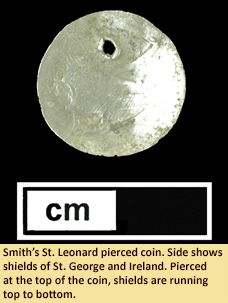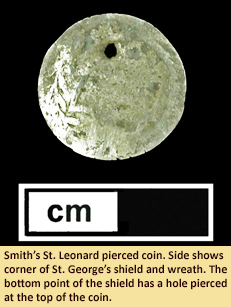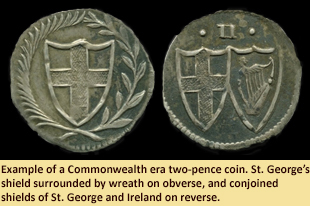Maryland Archaeological Conservation Laboratory
Main_Content
Curator's Choice 2010
Pierced Silver Coin
July 2010
By Alex GLass, MAC Lab Public Archaeology Asst.
 In 2010 at Jefferson Patterson Park and Museum, archaeologists recovered a silver pierced coin from the kitchen area at the Smith's St. Leonard Archaeological site (18CV91). After the coin was cleaned by conservation staff it became possible to identify the images on either side of it, the time period in which it was made, and where it was produced. The silver coin was minted in England during the Commonwealth Period, which dates from 1649 to 1660. The shield and cross of St. George surrounded by a wreath decorates one side, while the shields of St. George and Ireland are on the other (Mackay 1983: 83).
In 2010 at Jefferson Patterson Park and Museum, archaeologists recovered a silver pierced coin from the kitchen area at the Smith's St. Leonard Archaeological site (18CV91). After the coin was cleaned by conservation staff it became possible to identify the images on either side of it, the time period in which it was made, and where it was produced. The silver coin was minted in England during the Commonwealth Period, which dates from 1649 to 1660. The shield and cross of St. George surrounded by a wreath decorates one side, while the shields of St. George and Ireland are on the other (Mackay 1983: 83).
 Pierced coins are part of both European and African-American folk traditions. Both cultures use silver, especially coin silver, to ward off witchcraft and also to treat or prevent diseases and ailments (Fennel 2000: 286, Davidson 2004:27). English use of altered coins as amulets or charms was a common practice that may go as far back as the Pre-Christian era, while written sources date the use of pierced coins in England to the 17th century (Davidson 2004: 27-28). The cross in the center of St. George’s shield was possibly one reason why the coin was perforated. "The symbol of a cross on a metal medallion was considered a valid charm form by the Reformation clergy" and could have also held religious significance to whomever the coin belonged to, especially since the cross was present on both sides of this type of coin (Davidson 2004:28). Written records of folk practices among African-Americans during the 19th century suggest that "tying a piece of silver with a hole in it to one’s leg could create protection from malevolent forces," and also relieve "“rheumatism, cramps, teething" or provide "general good luck" (Davidson 2004: 37, Fennel 2000: 286). Pierced silver coins are often recovered from archaeological contexts associated with enslaved African-Americans including sites such as the Charles Carroll house in Maryland, and Andrew Jackson’s Hermitage plantation in Tennessee (Fennel 2000: 286, Russell 1997:68). The coins from these sites are often described as serving a medical or religious purpose by the enslaved people who used them.
Pierced coins are part of both European and African-American folk traditions. Both cultures use silver, especially coin silver, to ward off witchcraft and also to treat or prevent diseases and ailments (Fennel 2000: 286, Davidson 2004:27). English use of altered coins as amulets or charms was a common practice that may go as far back as the Pre-Christian era, while written sources date the use of pierced coins in England to the 17th century (Davidson 2004: 27-28). The cross in the center of St. George’s shield was possibly one reason why the coin was perforated. "The symbol of a cross on a metal medallion was considered a valid charm form by the Reformation clergy" and could have also held religious significance to whomever the coin belonged to, especially since the cross was present on both sides of this type of coin (Davidson 2004:28). Written records of folk practices among African-Americans during the 19th century suggest that "tying a piece of silver with a hole in it to one’s leg could create protection from malevolent forces," and also relieve "“rheumatism, cramps, teething" or provide "general good luck" (Davidson 2004: 37, Fennel 2000: 286). Pierced silver coins are often recovered from archaeological contexts associated with enslaved African-Americans including sites such as the Charles Carroll house in Maryland, and Andrew Jackson’s Hermitage plantation in Tennessee (Fennel 2000: 286, Russell 1997:68). The coins from these sites are often described as serving a medical or religious purpose by the enslaved people who used them.
 Some researchers believe the use of pierced silver coins is primarily a European practice, belonging in particular to English culture (Davidson 2004: 27, 30). So, it is possible that the Smith's St. Leonard coin belonged to a member of the Smith family, or one of their English servants, since most examples of pierced coins associated with African-Americans date from the second half of the 18th century and into the early 20th century (Samford, 2010: pers comm). The worn appearance of the coin could also suggest a significant amount of use, or that the coin had been handed down from one person to another. While it is difficult, even impossible, to know who this pierced coin at the Smith's St. Leonard site belonged to, the stories and traditions behind it are certainly very complex, and provide an interesting way of thinking about people from the past.
Some researchers believe the use of pierced silver coins is primarily a European practice, belonging in particular to English culture (Davidson 2004: 27, 30). So, it is possible that the Smith's St. Leonard coin belonged to a member of the Smith family, or one of their English servants, since most examples of pierced coins associated with African-Americans date from the second half of the 18th century and into the early 20th century (Samford, 2010: pers comm). The worn appearance of the coin could also suggest a significant amount of use, or that the coin had been handed down from one person to another. While it is difficult, even impossible, to know who this pierced coin at the Smith's St. Leonard site belonged to, the stories and traditions behind it are certainly very complex, and provide an interesting way of thinking about people from the past.
| References |
|
| Davidson, James M. |
| 2004 |
"Rituals Captured in Context and Time: Charm Use in North Dallas Freedman's Town (1869-1907), Dallas, Texas". Historical Archaeology 38(2):22-54. |
|
| Fennel, Christopher C. |
| 2000 |
"Conjuring Boundaries: Inferring Past Identities from Religious Artifacts". International Journal of Historical Archaeology 4(4): 281-309. |
|
| Russell, Aaron E. |
| 1997 |
"Material Culture and African-American Spirituality at the Hermitage". Historical Archaeology 31(2): 63-80. |
|
| Mackay, James |
| 1983 |
A History of Modern English Coinage: Henry VIII to Elizabeth II. Longman Group Limited, New York. |
|
| Samford, Patricia |
| 2010 |
Personal Communication - Maryland Archaeological Conservation Laboratory. |
|